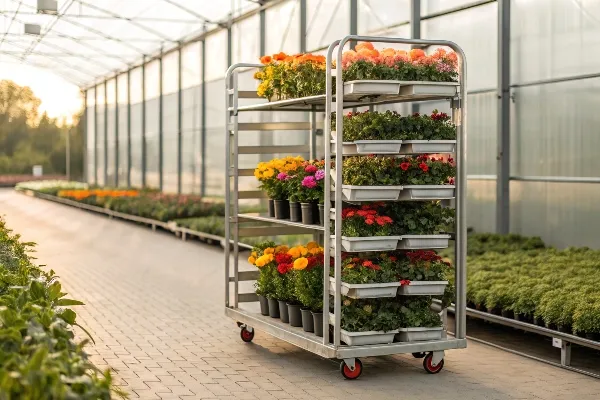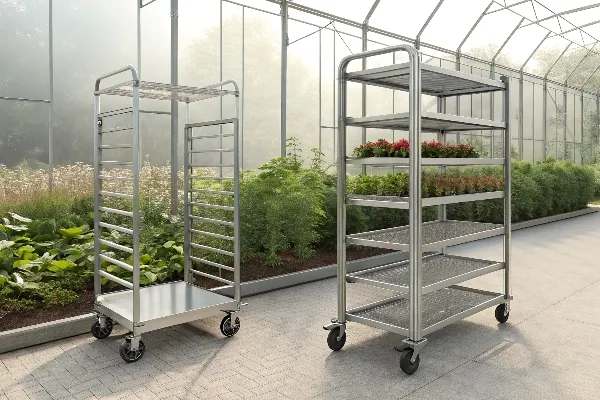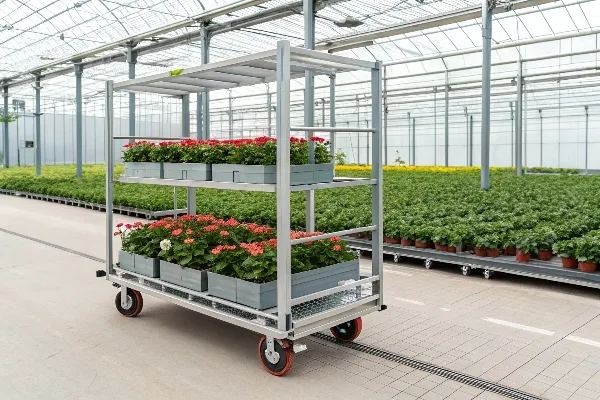Avoid your inquiry is delay response, please enter your WhatsApp/Skype along with the message, so we can contact you at the very first time.
We will reply you within 24 hours. If for urgent case, please add WhatsApp/WeChat: +8613791936882 ,. Or call +86-18678911083 directly.
In my 10 years of manufacturing transport solutions, I’ve often heard customers ask about the origin of Danish trolleys. The answer reveals an interesting piece of horticultural history.
Danish trolleys got their name from their origins in Denmark’s flower industry during the 1950s. Danish growers first developed these efficient wheeled shelf systems to move flowers and plants in their greenhouses and auction houses.

Vintage Danish trolley in a traditional flower auction house
Let me share my deep knowledge about Danish trolleys, from their fascinating history to their modern applications. As a manufacturer, I’ve seen how these trolleys have evolved while maintaining their core Danish design principles.
Many customers ask me about Danish trolley dimensions when planning their logistics setup. The right size can make a huge difference in operational efficiency.
A standard Danish trolley measures 565mm x 1350mm base dimensions and 1900mm in height. However, these measurements can be customized to meet specific needs while maintaining compatibility with standard transport systems.

Technical drawing showing Danish trolley measurements
| Component | Standard Measurement | Common Variations |
|---|---|---|
| Base Width | 565mm | 540-580mm |
| Base Length | 1350mm | 1300-1400mm |
| Height | 1900mm | 1800-2100mm |
| Shelf Depth | 400mm | 350-450mm |
| Load Capacity | 400-500kg | 300-600kg |
I’ve worked with countless greenhouse operators and flower distributors to optimize their trolley configurations. One memorable project involved helping a large flower auction house design a custom fleet of trolleys. We needed to balance the standard dimensions with their specific space constraints.
The standardization of Danish trolley sizes has revolutionized the flower industry. These dimensions weren’t chosen randomly – they’re the result of careful optimization for both transport efficiency and storage capacity1. When I visit European flower auctions, I see thousands of these trolleys moving smoothly through the facilities, their uniform sizes allowing for perfect integration with automated systems.
Each component of a Danish trolley serves a specific purpose. The base dimensions ensure stability while maximizing space usage in transport vehicles. The height is designed to allow easy access to upper shelves while fitting standard door heights. I always advise my customers to consider their specific needs while staying close to these standard measurements for compatibility reasons.
As someone who manufactures these units daily, I often explain to customers why we use the term “trolley” instead of cart or rack.
The term “trolley” comes from its mobile nature and efficient wheel system, designed specifically for smooth movement of heavy loads along level surfaces, similar to traditional rail trolleys.

Detailed view of Danish trolley wheels and base
| Feature | Purpose | Benefits |
|---|---|---|
| Wheel Design | Easy movement | Smooth transport |
| Base Structure | Weight distribution | Stability |
| Corner Posts | Vertical support | Modular assembly |
| Shelf System | Flexible loading | Space optimization |
| Locking Mechanism | Security | Safe transport |
The term “trolley” reflects its core function – efficient mobility. From my experience in manufacturing, I’ve seen how this design has evolved. The original Danish concept focused on creating a mobile shelving unit that could smoothly transport delicate flowers through auction houses and greenhouses.
Modern Danish trolleys maintain this fundamental principle while incorporating new technologies. I remember working with a major flower distributor who needed to transport orchids. We modified the traditional trolley design to include specialized shock absorption features2, but kept the basic “trolley” concept that makes these units so effective.
The wheel system is particularly crucial. Each trolley typically has four heavy-duty wheels3, with at least two being swivel casters. This configuration allows for easy maneuverability in tight spaces – something I demonstrate to every customer who visits our factory. The wheels need to be robust enough to handle heavy loads but smooth enough to prevent damage to floor surfaces.
The term “trolley” also implies a level of sophistication beyond simple carts. These units include features like adjustable shelving, secure locking mechanisms, and compatibility with automated transport systems. When I train new customers on using our products, I emphasize how these features combine to create a complete transport solution rather than just a wheeled shelf.
Danish trolleys represent a perfect blend of Danish engineering efficiency and practical functionality. Their standardized dimensions and mobile design continue to serve the horticultural industry effectively.